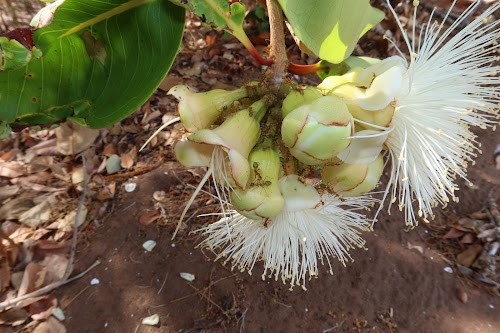Darwin to Gove - the fabulous Arnhem Land
Dear all
We are currently sitting in the delightful Gove harbour where we arrived 5 days ago, just in time to celebrate S2ee's birthday at the Gove Boat Club. There are five other yachts here, all of which we have met through our travels, and we have done heaps of socialising with our fellow sailors. We are all here waiting for the same thing - good weather conditions to cross the Gulf of Carpentaria (Gulf of Crap Interior?) to Cape York. That good weather has now arrived - two boat are departing today and the rest of us are departing tomorrow for a 3-4 night sail across the Gulf.
Gove harbour and the associated Nhulunbuy town are delightful - I expected a dirty, dusty, mining town - but it is quite the opposite. Green, neat and tidy and has all the services for a travelling yachty.
Entry to the harbour is marked by the now defunct alumina refinery, which closed a few years ago. So sad for the town to lose so many jobs. We were told that the bauxite ore body is reaching the end of its life and will be closed over the forthcoming years, as well as removing all the processing plant infrastructure and rehabilitating the site.
It took two weeks to reach Gove from Darwin. It was an early 2 am start to ensure we had a following current to pass through the Vernon Islands north of Darwin, and then we spent two nights at different anchorages while working our way across Van Dieman Gulf, below the Tiwi Islands, before rounding Cape Don (and its lighthouse) into the Arafura Sea. Another cape meant potentially strong currents and tidal overfalls, so we had to pick our passage time carefully. It was a bit bumpy rounding the Cape, but we motored through it to our first anchorage on the Coburg Peninsula in Popham Bay.
While all of Arnhem Land is Aboriginal land, requiring a permit to go ashore, the Coburg Peninsula forms Gurig National Park, so we were able to go exploring. We spent two nights at Port Essington, where the British colony attempted to establish a settlement named Victoria in 1838. The small community struggled to survive for 11 years until it was abandoned in 1849. All that remains is a few stones which formed chimneys and the foundations of the buildings.
We explored the national park near our picturesque anchorage - shell middens were evident of Aboriginal life here, and the vegetation was an interesting mix of open eucalypt woodland, interspersed with tropical palms and trees. Dung piles of the cow and horse feral animals were everywhere, an issue which the national park rangers find difficult to manage . Beware the green tree ants, they give a painful bite!
We then moved across the Arnhem Land coastline, with an overnight stop in the King River and an overnight sail to the Wessel Islands, off the north eastern tip of Arnhem Land. En route, we saw Aboriginal outstations on some of the many islands, and occasionally some groups of people camping or fishing. I took the opportunity of passage through island chains to fish and we enjoyed meals of shark and queenfish.
The Wessel Islands are extraordinary. They are sandstone islands and appear very dry and sparsley vegetated, but very beautiful. There was an abundance of birds and mammals there - the beaches were covered in bird and macropod foot prints and we saw wallabies and a bandicoot, pelicans, eagles, and a beach stone curlew with chicks, a bird I have never seen before. To add to the beauty, were were visited by two pilot whales as we approached the islands.
To get to Gove, you need to travel through the Wessel Islands or take the long route around the tip. There are several passages, the most famous being the Hole in the Wall, otherwise known as the Gugari Rip. Here, currents flow at up to 10 knots through a 60 m wide, 10 metre deep channel between the islands. Looking at the satellite photo, you can see the large sandstone blocks that make up the Wessel Islands, and the Rip looks like an area where a sandstone block fissure has worn away over thousands of years.
We had great fun passing through the Rip on a late flood tide, when there was a bit of a current pushing us through but not so much to affect the handling of the boat. We only got up to about 11 knots speed over ground, with a 4-5 knot following current, but that was great fun!
We are leaving Gove at first light tomorrow morning, heading for Seisia, a small town at the tip of Cape York. Will update our Cape York adventures in the next blog.
Love to all
Naomi and S2ee





















Greetings from the Urchins - & congratulations on crossing the Gulf.
ReplyDelete